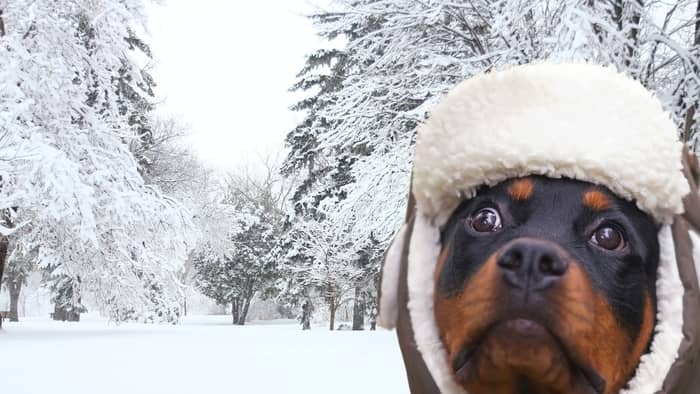Last Updated on November 1, 2021 by
At what temperature do dogs get cold during winter, and how can you ensure you have protected your pets from the winter cold and low temperatures.
We all know that outdoor exercise for most dogs is best for mental stimulation and physical well-being. But what should you do when it gets cold outside? When does it become risky for your dog to spend time outdoors?
Let’s take a closer look at the dangers of the winter weather and how we can protect our furry friends from the cold.
Table of Contents
Do Dogs Get Cold In Winter?
The answer to this question is Yes; dogs do get cold in winter, just like humans. They are susceptible to frostbite and hypothermia.
The dry air indoors is just as hard for you and your dog. While you keep them indoors during the cold season, providing them with special care is essential. Ensure you provide a constant source of water for your dogs to drink throughout the day. If your dog experiences a dry nose in winter, you can get a pet-friendly nose balm to keep it well hydrated.

Learn more about: How Much Do Rottweilers Shed? A Very Hairy Guide
How Cold Is Too Cold For Dogs To Be Outside?
However, a golden rule of thumb is if it is too cold for you, it is likely too cold for them. This varies from dog to dog. Dog breeds with thicker coats are initially from colder climates and are likely to have a high tolerance for low temperatures. For example, a Siberian husky is expected to have more patience for the cold than an Italian Greyhound with short hair.
Age is also a factor in cold tolerance. Puppies and older dogs will have a tough time regulating their body temperatures in the hot and cold seasons. When it’s freezing, you should provide them with a sweater or a coat and limit their exposure to the cold temperatures.
Dogs facing threatening health challenges like kidney disease, heart disease, and diabetes are more susceptible to the cold.
So At What Temperatures Do Dogs Get Cold?
Dogs in cold weather should be observed from the time the temperatures fall lower than 45 degrees F. At this point, some dogs will begin to feel uncomfortable.
At 32 degrees F, dogs with thin coats, small breed dogs, very young, old, or sick dogs should be protected from cold.
When temperatures go under 20 degrees F, your dog could develop cold-associated health problems like frostbite and hypothermia.
The best way to take care of your dog during the cold season is to keep a close eye on their behavior. In case you notice your dog shivering or acting anxious, slowing down, whining, holding up one or more paws, searching for warm locations, it’s time to keep them inside.
Dogs React To Different Temperatures
How cold can dogs handle depends on each dog individually? A temperature can feel downright balmy to one dog while it sends another in search of a shelter. What makes the dog react differently to cold?
- Their coat type. Dogs that have thick, double-layered coats are the coldest tolerant. In most cases, these breeds originated from Northern climates and may have other physiological attributes that help them thrive in cold temperatures.
- The coat color. On a sunny day, the black, brown, and other dark-coated dogs absorb a good amount of heat from the sun. This keeps them warmer in comparison to their light-colored friends.
- Their size. The smaller the dog, the more skin it has, which makes it lose more heat. Therefore, small dogs get colder more readily than large dogs.
- Their Weight. Body fat is known to be a good insulator even in humans. Thinner dogs get colder quicker than the fat ones. That said, be careful not to overfeed your dog and make it obese in the name of protecting it from freezing. The health risks of obesity outweigh any benefits.
- Conditioning. We all know how it feels the first time the cold season sweeps in, but our bodies adjust after a long cold season. It is the same for dogs. Those that are used to handling cold temperatures handle them with more ease than those that have not.
- Their Age and Health. The young puppies, the old, and the sick cannot regulate their body temperatures compared to the healthy and energetic ones. They will need more protection.
The Temperature Is Not The Only Factor That Determines How Cold A Dog Feels
Besides the average temperature that registers on a thermometer, other factors affect how dogs feel the cold.
- Activity. If your dog is very active while outside, it could generate enough extra body heat to keep it comfortable even when the temperature is relatively low.
- Wind chill. A breeze can easily cut through a dog’s coat, decreasing its ability to insulate and protect itself against cold temperatures.
- Cloud cover. Cloudy days generally feel colder than sunny days since dogs cannot get some sun to warm themselves.
- Dampness. Heavy fog, rain, wet snow, going for a swim, any form of wetness that soaks through the dog’s coat can quickly chill your dog even if the temperatures are not too cold.
Conclusion
A cold dog may shiver, lift its paws off the ground, or assume a hunched position. In extreme cases, your dog can easily suffer from hypothermia. Hypothermia signs include – muscle stiffness, lethargy, decreased mental alertness, weakness, and loss of consciousness. In case you notice any of these signs, seek medical treatment fast.
If you notice that your dog is getting too cold, consider bundling it up in warm layers. Please note that smaller breeds and breeds with shorter hair and thin coats tend to get cold faster. Protect them!
If it is too cold for you, know that is the same for your furry friend. You can get your dog a sweater or coat to wear in the cold season.
Do not leave your dog unattended in a cold car or room at whatever temperature dogs get cold. This can accelerate symptoms of hypothermia. If you notice any signs of hypothermia, call your vet immediately to have your dog checked.
